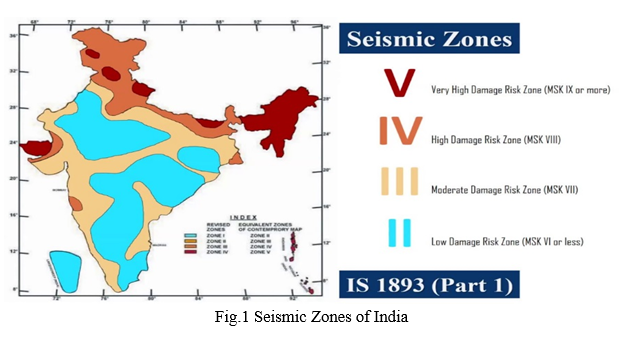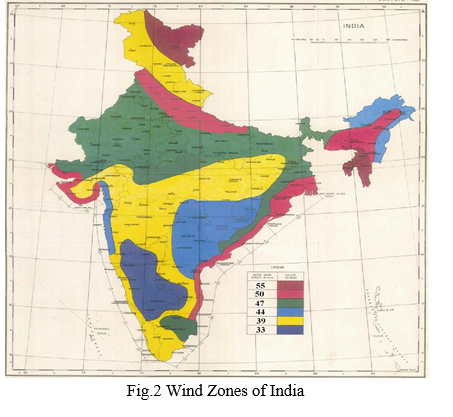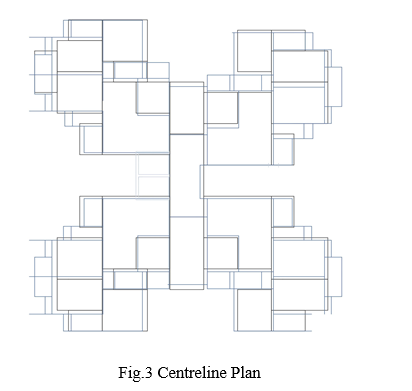Ijraset Journal For Research in Applied Science and Engineering Technology
- Home / Ijraset
- On This Page
- Abstract
- Introduction
- Conclusion
- References
- Copyright
Comparison of Seismic Zone-II & Zone-V With Respect to Wind Effects on High Rise Structure Using ETABS
Authors: Utkarsh R. Nishane, Sonali Patil
DOI Link: https://doi.org/10.22214/ijraset.2022.40015
Certificate: View Certificate
Abstract
Reinforced concrete (RC) framed buildings with ground parking are commonly seen in major cities. These RC framed structures are constructed in densely populated cities of developing countries all around India. Earthquakes in the past have major effects on the life and economy as to the buildings and infrastructure was poorly built. Earthquake and wind are both juggernaut as they cannot be stopped in any way, though the solutions are provided only to safeguard the buildings. It is therefore necessary to analyse and modify the building elements satisfactorily to withstand earthquake and wind effects. The Indian code for wind load resisting structure is prepared for analysis of the building and to design the structure for resisting wind loading effects. The wind loading is predominant in effect for three seconds. When the wind loading is taken account the internal pressure of wind and external pressure of the wind loading is taken into account. Wind acts on the surface that is been exposed to it. Mostly windward wind is considered to act on the building. The parameter from analysis of the wind loading on the structure is compared to seismic loading in different zones. Practically seismic effect on building is unpredictable though there is specification suggested in IS code for designing of earthquake resistant structure. The structure is accordingly designed and analysed with proper method with respect to the building height and plan aspect. The response of the building to lateral forces of seismic loading is considered to be in horizontal direction whereas the force acting in the vertical direction is negligible. The response of the building is considered to the same movement that of the shaking to earth motion. The response of building in wind loading effect is compared with response of the elements in seismic loading effects. Up to a certain height wind effect is considered to be same. Seismic loading affects from the foundation itself and the lateral force shake the building in the direction of earthquake motion. The design criteria can be changed when building can be efficiently analysed for both wind and seismic effect. With the help of comparison of the building structure in seismic and wind loading effect, the building can be designed safely if in the analysis the structure is shown failure. Precautions can be adopted in designing of the building material or the building elements. The consulting structural engineer needs to design, and build to safeguard the building from the seismic and wind effect
Introduction
I. INTRODUCTION
India is a country with a vast variation of geographical conditions. These varying conditions are observed in India which makes prone to many calamities. India has major calamities like earthquake and cyclones majorly. There is a population of India which already lives in major cities, now for opportunities there is migration of Indian village population to cities like Mumbai, Delhi, Kolkata, Chennai etc. This makes cities overcrowded, resulting in reduction of land area to live. Land available is less to construct any building thus building size is increased in vertical direction only. Thus tall structures are constructed for residential, commercial, official purposes. So according to IS code 16700-2017, super tall-structures whose height are above 250 m; and for tall structures whose height is above 50 m but less than 250 m are to be considered when RCC building is taken into account. Usually building height is taken according to IS code and all criteria are satisfied. Buildings are increasing with height they are more susceptible to failures which are due to wind and earthquake. Both earthquake and wind forces are unpredictable and uncontrollable. Accordingly the building structure is built to resist wind and earthquake lateral forces. Building criteria are developed in IS codes according to the zones in which cities are considered to be built. In general, for design of tall buildings both wind as well as earthquake loads need to be considered. Governing criteria for carrying out dynamic analyses for earthquake loads are different from wind loads. According to the provisions of Bureau of Indian Standards for earthquake load, IS 1893(Part 1):2016 Criteria for Earthquake Resistant Design of Structures, height of the structure, seismic zone, vertical and horizontal irregularities, soft and weak storey necessitates dynamic analysis for earthquake load. The contribution of the higher mode effects are included in arriving at the distribution of lateral forces along the height of the building. As per IS 875(Part 3):2015 Design Loads Other than Earthquake for Buildings and structures, when wind interacts With a building, both positive and negative pressures occur simultaneously, the building must have sufficient strength to resist the applied loads from these pressures to prevent wind induced building failure. Load exerted on the building envelope are transmitted to the structural system and they in turn must be transferred through the foundation into the ground, the magnitude of the wind pressure is a function of exposed basic wind speed, topography, building height, internal pressure, and building shape. In order to design a structure to resist wind and earthquake loads, the forces on the structure must be specified. The exact forces that will occur during the life of the structure cannot be anticipated. Most National Building Codes identify some factors according to the boundary conditions of each building considered in the analysis to provide for life safety. A realistic estimate for these factors is important; however the cost of construction and therefore the economic viability of the project is essential. The code introduces simplified methods for the design which depend on different factors for wind and earthquake that govern the design and influence the results.
ETABS is the present day leading design software in the market. Many design company’s use this software for their project design purpose. So, this paper mainly deals with the comparative analysis of the results of zone-ii and zone-v with same medium soil in both the zones. In this case, G+17 storey structure is modelled using ETABS software. The height of each storey is taken as 3meter making the total height of the structure 36 meter. Analysis of the structure is done and then the results generated by this software are compared in between zone-2 and zone-5 of the structure using IS 1893:2002 & with respect to same wind pressure on structure using ,IS code 875 (part 3):2015 , wherever the price of land is high and any horizontal growth isn't possible because of inaccessibility of area, so we the engineers taken a step forward and build buildings vertically After an earthquake happens it causes nice harm because of seismic motion when the peak of building is increased the wind load result conjointly acts on building. Structures are designed to resist these unforeseen forces and may have decent stiffness and strength to manage displacement at supports. Even the arrange configuration of building depends upon however the structure reacts on loading. For symmetrical building the deformation is lesser compared to a unsymmetrical arrange of columns and beam. So the first point we consider is the building should be symmetric here a neighbourhood of structure is taken into account and also the centre line diagram is computed from AUTOCAD to ETABS. Then a model is been ready in ETABS The analysis of this structure is finished to match the bottom reactions once loading happens and deformation of various beams is observed. And compared the building in zone-iii and zone-iv with all the parameters like storey shear, storey stiffness, shear force and bending moment’s base shear and storey drifts are taken for seismic analysis according to Indian standards rules and regulations.
A. Earthquake
India has varied land condition; there are tectonic plates which are moving along the fault lines which makes the land surface shake. This shaking of land is Earthquake. Earthquakes are themselves not fatal but the building in which people are living or working and building is weak structurally.
This can prove to be fatal. Earthquakes are unpredictable thus making the aftermath dangerous. Earthquakes are juggernauts as they cannot be stopped. IS codes have already clarified in ANNEXE E of IS code 1893(part1):2016, all the cities with population of over three lakh and the zones in which the cities lie. Based on the occurrence of earthquakes in the past around India, the country is divided into four seismic zones, namely zones II, III, IV, V, where II is the least severe and V is the most severe. Based on this zoning, about 60% of India’s land area is under moderate seismic threat or more, i.e., under seismic zone III or above in fact, the Gujrat, Latur earthquake which were fatal. Even now amongst our four mega-cities, Delhi is in seismic zone IV, which Mumbai, Calcutta and Chennai are in seismic zone III. Despite this level of seismic hazard, little is being done, particularly in these cities, to make the development akin to earthquake shaking. The quality of both design engineering and construction is way behind the expected seismic standards.
The experience of severe earthquake has shown that when structures were built in accordance with seismic codes, the consequences of earthquakes were least severe. The characteristic of seismic ground vibrations expected at any site depend on magnitude of earthquake, its focal depth, epicentre distance, characteristics of path through which seismic waves travel, and soil strata on which seismic waves travel, soil strata on which structure is founded. The random earthquake ground motions, which cause structure to oscillate, can be resolved in any three mutually perpendicular directions. The predominant direction of ground vibration is usually horizontal.

- Wind
Wind is air in motion relative to the surface often earth. The primary cause of wind is traced to earth's rotation and differences in terrestrial radiation. The radiation effects are primarily responsible for convection either upwards or downwards. The wind generally blows horizontal to the ground at high wind speeds. Since vertical components of atmospheric motion are relatively small, the term 'wind' denotes almost exclusively the horizontal wind. Winds are proven to be fatal because there are juggernauts, they cannot be controlled. Building in which people are residing or working should resist the wind effects. Wind affects the surface of the exposed area of the building. Wind forces static and dynamic should be taken into account when designing the building, Wind speeds vary randomly both in space and time and hence assessment of wind loads and response prediction are very important in design of several buildings and structures. Buildings shall also be designed with due attention to the effects of wind on the comfort of people inside and outside the buildings. The liability of a building to high wind pressures depend not only upon the geographical location and proximity of other obstructions to air flow but also upon the characteristics of the structure itself. The effect of wind on the structure as a whole is determined by the combined action of external and internal pressures acting upon it. In all cases, the calculated wind loads act normal to the surface to which they apply. According to IS code 875 (part 3):2015 Wind speed may be taken as constant up to a height of 10 m. Accordingly basic wind speed is categorized in zones, cities are classified in those zones. Basic wind speed is based on gust velocity averaged over a short time interval of about 3 seconds. Basic wind speed for some important cities/towns is given in ANNEXE A of IS code 875(part3):2015.

LITRATURE REVIEW
- Mindala Rohini, T.Venkat Das, Seismic analysis of residential building for different zones, International Journal Of Resent Technology And Engineering (IJRTE)Volume-7,issue-April-2019, The story shear in both response spectrum method and time history method maximum at ground. Its value is higher for zone-v than zone-III.
- k. Naga Sai Gopal, N.Lingeshwaram ,Analysis and design of G+5 residential building by using E-TABS, International Journal Of Civil Engineering And Technology (IJCIET),Volume – 8, Issue- 4,April2017, The structure is design based on E-TABS, and the theory of LSM which provide adequate strength, serviceability and durability besides economy.If the beam fails the dimensions of beam and column should be changed.
- Suhail Zikar Khan, ShaikRehman, S.Zubeeruddin, Effect of wind and seismic analysis and design of multistoried residential building of (G+30), International Journal Of Research, Volume-8,Issue- 3,march 2021, The study clearly help us to understand the significant difference between the seismic behavior of buildings .Analysis results of structural integrity of building in withstanding the design earthquake loading were conducted & were judge to be safe.Story shear is maximum for moments as we compared with forces in all stories.
- Asra Fatima , Sashi Kumar, Behavior of vertical irregular building in different seismic zones, European Journal Of Molecular & Clinical Medicine, Volume-7,Issue- 08,2020, Maximum lateral displacement occurs at top storey and minimum at bottom storey .Increase in zone factor increases the storey shear.
- Dr. Suchita Hirde, Mr. Vinay Magadum, Severity of earthquake forces against wind forces for multistory RCC building. IOSR Journal Of Mechanical And Civil Engineering (IOSR-JMCE), Effect of both earthquake and wind forces on multistory building increases with increase in height of building.
- Yashashri Ankalkhope, Pratik Harmalkar., Wind & seismic analysis of building Using ETABS, ICONIC Research & Engineering Journals,Volume -4,Issue-12,June 2021, They have analyse & design parameters of rectangular and circular column using Etabs software.
- Suhail Zikar Khan, ShaikRehman, S.Zubeeruddin, International Journal Of Research,Volume-8,Issue- 3,march 2021, The study clearly help us to understand the significant difference between the seismic behavior of buildings.Analysis results of structural integrity of building in withstanding the design earthquake loading were conducted & were judge to be safe. Story shear is maximum for moments as we compared with forces in all stories.
- A. NagaSai, G. Radha Devi, Seismic and wind effect on high rise structure using ETABS, IJRASET, Volume 6 Issue 2, feb.2018., Manually calculated lateral forces due to wind effects and etabs calculated lateral forces due to wind effects are similar.Calculation of seismic weight with manual analysis and software analysis approximately shows same result.
- Seismic and wind analysis of multi storey building by using ETABS software, JETIR, march2019, Volume6, issue-3, Analysis was done by using etabs software and successfully verified manually as per IS. 456-2000, ETABS is perfect software for analysis and designing.
- Suhail Zikar Khan, ShaikRehman, S.Zubeeruddin International Journal Of Research,Volume-8,Issue- 3,march 2021, The study clearly help us to understand the significant difference between the seismic behavior of buildings.Analysis results of structural integrity of building in withstanding the design earthquake loading were conducted & were judge to be safe. Story shear is maximum for moments as we compared with forces in all stories.
- C.V.S. Lavanya, Emily.P.Pailey, Md. Mansha Sabreen, ANALYSIS AND DESIGN OF G+4 RESIDENTIAL BUILDING USING ETABS, International Journal of Civil Engineering and Technology (IJCIET) Volume 8, Issue 4, April 2017, 3. Seismic analysis was done by using ETABS software and successfully verified manually as per IS 1893-2002.. There is a gradual increase in the value of lateral forces from bottom floor to top floor in software analysis, project deals with provision of earthquake resistant structure which is also economic.
- S Abhishek, Manoj S K, Roopa B D, Bhagyashree M S, Guruprasad C H M, Design and Analysis of Residential Building using E-TABS, International Research Journal of Engineering and Technology (IRJET), Volume: 05 Issue: 05 | May-2018, The analysis was done using the software package ETAB and drawing details in AutoCAD and REVIT. The structural components were designed manually in addition to the software design.
III. METHODOLOGY / PROCEDURE
- Step - 1: Initial setup of Standard Codes and Country codes.
- Step - 2: Creation of Grid points & Generation of structure After getting opened with ETABS we select a new model and a window appears where we had entered the grid dimensions and story dimensions of our building.
- Step - 3: Defining of property Here we had first defined the material property by selecting define menu material properties. We add new material for our structural components (beams, columns, slabs) by giving the specified details in defining. After that we define section size by selecting frame sections as shown below & added the required section for beams, columns etc.
- Step - 4: Assigning of Property After defining the property we draw the structural components using command menu. Draw line for beam for beams and create columns in region for columns by which property assigning is completed for beams and columns.
- Step - 5: Assigning of Supports by keeping the selection at the base of the structure and selecting all the columns we assigned supports by going to assign menu joint\frame Restraints (supports) fixed.
- Step - 6: Defining of loads in ETABS all the load considerations are first defined and then assigned. The loads in ETABS are defined as using stat
- Step - 7: Assigning of Dead loads after defining all the loads D but in E-TABS automatically taken care by the software i.e., inbuilt
- Step - 8: Assigning of Live loads Live loads are assigned for the entire structure including floor finishing.
- Step - 9: Assigning of wind loads Wind loads are defined and assai wind angle. But since this is a G+12 Residential Building having total height less than 12 meters there is no need of assigning of wind loads or earth quake loads.
- Step - 10: Assigning of Seismic loads Seismic loads are defined and assigned as per IS 1893: 2002 by giving response reduction factor in X and Y directions having total height less than 12 meters there is no need of assigning Seismic loads.
- Step - 11: Assigning of load combinations Using load combinations command in define menu be taken as mentioned in above
- Step - 12: Analysis after the completion of all the above steps we have performed the analysis and checked for errors.
- Step - 13: Design After the completion of analysis we had performed concrete design on the structure as per IS 456:200 0. ETABS performs the design for.
V. CENTERLINE PLAN

Conclusion
A.For this study many investigation has been done to calculate all required wind & seismic data. B.Analysis of model comprises mainly linear static & dynamic analysis. C.Analysis of all model gives the result I the form of story displacement, Story drift, Base shear, Overturning moments, Acceleration, Time period. D.Seismic analysis was done by using ETABS software and successfully verified manually as per IS 1893-2002. E.There is a gradual increase in the value of lateral forces from bottom floor to top floor in software analysis.
References
[1] “Analysis and Design Construction of RC High Rise Buildings by ETABS”.by D. ShaikFakrudin, Dr. B. Ramesh Babu, G. Raghu Yada. [2] Abhay guleria,”structural analysis of a multistorey building using ETABS for different plan configurations,” International journal of engineering research and technology,ISSN:2278-0181,vol.3issue 5,may2014. [3] Ashish S. Agrawal, S.D.Charkha (2012), “Effect of change in shear wall location on storey drift of multistorey building subjected to lateral loads”, International Journal of Engineering Research and Applications (IJERA) ISSN: 2248-9622, Vol. 2, Issue 3, pp 1786-1793 Anuj Chandiwala (2012), “Earthquake Analysis of Building Configuration with Different Position of Shear Wall”, International Journal of Emerging Technology and Advanced Engineering, ISSN 2250-2459, Vol. 2, Issue 12, pp 347-353 [4] Anand, N. Mightraj, C.Prince, Arulraj, G. (2010), “Seismic Behavior of RCC Shear Wall Under Different Soil Conditions”, Indian Geotechnical Conference, pp 119-122 [5] Baldev D.prajapati and D.R.panchal “study of seismic and wind effect on multistorey RCC, steel and composite building”, international journal of advances in engineering &technology, ISSN:22311963,september 2013. [6] Bureau of Indian Standards (BIS). Criteria for Earthquake Resistant Design of Structures, IS 1893-2002, New Delhi. [7] Bureau of Indian Standards (BIS). Code of Practice For Design Loads (Other Than Earthquake) For Buildings And Structures, Part 1: Dead Loads - Unit Weights of Building Material And Stored Materials, IS 875-1987, New [8] Bureau of Indian Standards (BIS). Plain and Reinforced Concrete Code of Practice IS 456-2000, New Delhi. [9] Bureau of Indian Standards (BIS). Code of Practice For Design Loads (Other Than Earthquake) For Buildings And Structures, Part 3: Wind Loads, IS 875-1987, New Delhi. [10] Dr. K. R. C. Reddy, Sandip A. Tupat. (2014), “The effect of zone factors on wind and earthquake loads of high rise structures”, IOSR Journal of Mechanical and Civil Engineering (IOSR-JMCE). [11] And Structures, Part 2: Imposed Loads, IS 875-1987, New Delhi. [12] IS: 875 (part1):, “Indian standard code of practice for design loads for building and structures, Dead loads”burea of Indian standards, New Delhi. [13] IS: 875(part2):,”Indian standard code of practice for design loads for building and structures, live loads “bureau of Indian standards ,New Delhi. [14] IS: 1893 (part1):2002, “criteria for earthquake resistant design of structures”, bureau of Indian standards, new Delhi. [15] O.Esmaili S. Epackachi M. Samadzad and S.R. Mirghaderi. (2008), “Study of Structural RC Shear Wall System in a 56-Story RC Tall Building”, The 14th World Conference on Earthquake Engineering, Beijing, China.
Copyright
Copyright © 2022 Utkarsh R. Nishane, Sonali Patil. This is an open access article distributed under the Creative Commons Attribution License, which permits unrestricted use, distribution, and reproduction in any medium, provided the original work is properly cited.

Download Paper
Paper Id : IJRASET40015
Publish Date : 2022-01-20
ISSN : 2321-9653
Publisher Name : IJRASET
DOI Link : Click Here
 Submit Paper Online
Submit Paper Online

